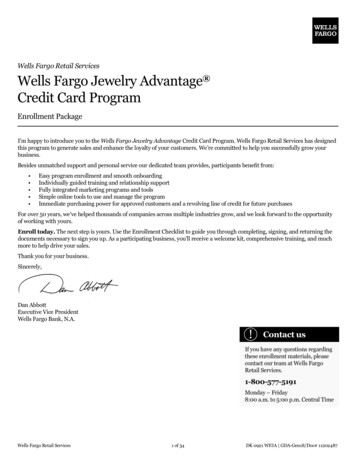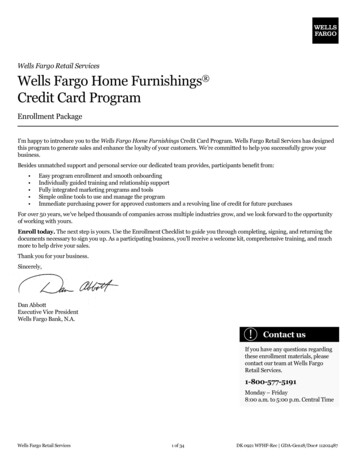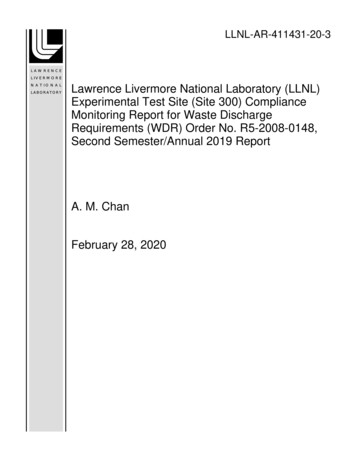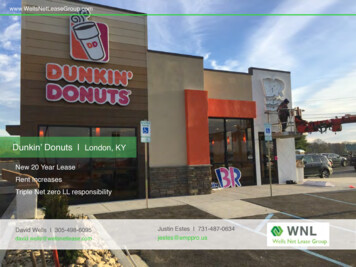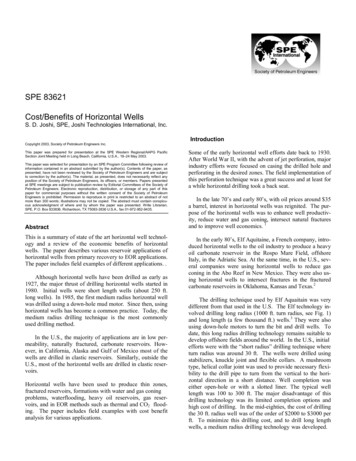
Transcription
SPE 83621Cost/Benefits of Horizontal WellsS. D. Joshi, SPE, Joshi Technologies International, Inc.Copyright 2003, Society of Petroleum Engineers Inc.This paper was prepared for presentation at the SPE Western Regional/AAPG PacificSection Joint Meeting held in Long Beach, California, U.S.A., 19–24 May 2003.This paper was selected for presentation by an SPE Program Committee following review ofinformation contained in an abstract submitted by the author(s). Contents of the paper, aspresented, have not been reviewed by the Society of Petroleum Engineers and are subjectto correction by the author(s). The material, as presented, does not necessarily reflect anyposition of the Society of Petroleum Engineers, its officers, or members. Papers presentedat SPE meetings are subject to publication review by Editorial Committees of the Society ofPetroleum Engineers. Electronic reproduction, distribution, or storage of any part of thispaper for commercial purposes without the written consent of the Society of PetroleumEngineers is prohibited. Permission to reproduce in print is restricted to an abstract of notmore than 300 words; illustrations may not be copied. The abstract must contain conspicuous acknowledgment of where and by whom the paper was presented. Write Librarian,SPE, P.O. Box 833836, Richardson, TX 75083-3836 U.S.A., fax 01-972-952-9435.AbstractThis is a summary of state of the art horizontal well technology and a review of the economic benefits of horizontalwells. The paper describes various reservoir applications ofhorizontal wells from primary recovery to EOR applications.The paper includes field examples of different applications. .Although horizontal wells have been drilled as early as1927, the major thrust of drilling horizontal wells started in1980. Initial wells were short length wells (about 250 ft.long wells). In 1985, the first medium radius horizontal wellwas drilled using a down-hole mud motor. Since then, usinghorizontal wells has become a common practice. Today, themedium radius drilling technique is the most commonlyused drilling method.In the U.S., the majority of applications are in low permeability, naturally fractured, carbonate reservoirs. However, in California, Alaska and Gulf of Mexico most of thewells are drilled in clastic reservoirs. Similarly, outside theU.S., most of the horizontal wells are drilled in clastic reservoirs.Horizontal wells have been used to produce thin zones,fractured reservoirs, formations with water and gas coningproblems, waterflooding, heavy oil reservoirs, gas reservoirs, and in EOR methods such as thermal and CO2 flooding. The paper includes field examples with cost benefitanalysis for various applications.IntroductionSome of the early horizontal well efforts date back to 1930.After World War II, with the advent of jet perforation, majorindustry efforts were focused on casing the drilled hole andperforating in the desired zones. The field implementation ofthis perforation technique was a great success and at least fora while horizontal drilling took a back seat.In the late 70’s and early 80’s, with oil prices around 35a barrel, interest in horizontal wells was reignited. The purpose of the horizontal wells was to enhance well productivity, reduce water and gas coning, intersect natural fracturesand to improve well economics. 1In the early 80’s, Elf Aquitaine, a French company, introduced horizontal wells to the oil industry to produce a heavyoil carbonate reservoir in the Rospo Mare Field, offshoreItaly, in the Adriatic Sea. At the same time, in the U.S., several companies were using horizontal wells to reduce gasconing in the Abo Reef in New Mexico. They were also using horizontal wells to intersect fractures in the fracturedcarbonate reservoirs in Oklahoma, Kansas and Texas.2The drilling technique used by Elf Aquaitain was verydifferent from that used in the U.S. The Elf technology involved drilling long radius (1000 ft. turn radius, see Fig. 1)and long length (a few thousand ft.) wells.3 They were alsousing down-hole motors to turn the bit and drill wells. Todate, this long radius drilling technology remains suitable todevelop offshore fields around the world. In the U.S., initialefforts were with the “short radius” drilling technique whereturn radius was around 30 ft. The wells were drilled usingstabilizers, knuckle joint and flexible collars. A mushroomtype, helical collar joint was used to provide necessary flexibility to the drill pipe to turn from the vertical to the horizontal direction in a short distance. Well completion waseither open-hole or with a slotted liner. The typical welllength was 100 to 300 ft. The major disadvantage of thisdrilling technology was its limited completion options andhigh cost of drilling. In the mid-eighties, the cost of drillingthe 30 ft. radius well was of the order of 2000 to 3000 perft. To minimize this drilling cost, and to drill long lengthwells, a medium radius drilling technology was developed.
2JOSHI, S. D.The first medium radius horizontal well was drilled in 1985.4Turn radius for the medium radius wells was about 300 ft.to 600 ft. and it utilized down-hole motors. To date, medium radius technology remains the most common methodto drill horizontal wells. This drilling method provides various completion as well as artificial lift options. It is quitecommon to see well lengths varying from 1000 ft. to 5000 ft.Short radius technology has also evolved over time andthere has been significant cost reduction. This, however,remains a niche market mostly in low productivity wells inthe U.S. and parts of China. In the U.S., small independentswith marginal wells (production rate less than 10 BOPD) uselow cost, short radius technology to enhance well production.Recent DevelopmentsIn the last few years, several technical advances have beenmade. Some of these advances include LWD and MWD(logging while drilling) and geo-steering. Technologies areavailable to drill and complete multi-lateral wells, drill withcoiled tubing, drill under-balance, and use rotary steerableassembly to drill straight holes. For completion, one cancement and stimulate horizontal wells in low permeabilityformations and gravel pack long horizontal wells in highpermeability formations. These new technologies are brieflydescribed below.Technologies have been developed to drill multi-lateralwells. These wells have various shapes and offer the possibility of different types of completions to isolate and controlproduction from different branches of multi-laterals (seeFigure 2). Nevertheless, through the year 2002, the largescale multi-lateral applications are seen in heavy oil reservoirs (where wells are completed with slotted liners) and incarbonate reservoirs using open hole completions. A largescale of applications of multi-laterals is found in the heavyoil reservoirs in Canada and Venezuela and in the carbonatereservoirs in the Middle East.5,6Another development is under balance drilling of horizontal wells to minimize formation damage, especially inlow permeability formations.7 The technique has been verypopular in Canada. In addition to low permeability formations, under-balance drilling is also important in depleted gasreservoirs where current reservoir pressure is significantlyless than the hydrostatic pressure. If one uses liquid drillingfluids, it would result in an excessive mud loss, resulting inreduced well productivity and possibly a non-commercialwell. Under-balance drilling allows us to drill and completehorizontal wells in depleted gas reservoirs.8 Typically, horizontal well productivity is two to five times larger than thevertical well productivity. Thus, for the given economic gasrate limit, horizontal wells could be produced with up to 1/2to 1/3 reservoir pressure as compared to the reservoir pressure required for economic production from a vertical well.SPE 83621This results in a large enhancement of producible reservesfrom discovered, depleted gas fields. Horizontal wells aredrilled in the depleted gas reservoirs in Texas, Oklahomaand also in Canada.Typically, drilling a re-entry well is less expensive thandrilling a grass roots horizontal well from the surface. There-entry well costs could be further reduced by using theCoiled tubing drilling technique. This is especially importantin Alaska where drilling costs are high.9Significant advances have also been made in drillingtechnology to drill straight horizontal holes. The straighthorizontal holes are necessary to obtain reliable gravel packcompletions and to eliminate acid accumulation in the lowspots along the length of the horizontal well. The corrosiveacid effects can significantly reduce liner life in offshore,expensive, high production rate wells in deep waters. Progressively, steerable rotary assembly is used to drill horizontal wells, especially in deep water reservoirs to achievefairly straight drilled holes.10Most of the horizontal wells drilled in North America arecompleted as open hole or with slotted liners. The stimulation of horizontal wells is found to be necessary in many lowpermeability formations. Stimulation techniques are available for open hole horizontal wells using liquid fracs (eitherwater fracs or acid fracs). In a few cases in onshore U.S.,horizontal wells are cemented and fracture stimulated in thelow permeability formations, such as Devonian formation inWest Texas 11 (12000 ft deep, k 0.05 md), Diatomite 12formation in Belridge Field in California, and Kuparek Fieldin Alaska.13Open-hole gravel packing has also been an importantdevelopment, especially for deep water reservoirs, which aretypically high permeability, unconsolidated reservoirs.14Open hole gravel packing is used quite commonly in horizontal wells in the Gulf of Mexico. 15Cost/Benefits Of Horizontal WellsDisadvantages of horizontal wells are:1. High cost as compared to a vertical well. In the U.S., anew horizontal well drilled from the surface, costs 1.5 to2.5 times more than a vertical well. A re-entry horizontal well costs about 0.4 to 1.3 times a vertical well cost.2. Generally only one zone at a time can be produced usinga horizontal well. If the reservoir has multiple pay-zones,especially with large differences in vertical depth, orlarge differences in permeabilities, it is not easy to drainall the layers using a single horizontal well.3. The overall current commercial success rate of horizontalwells in the U.S. appears to be 65%. (This success ratioimproves as more horizontal wells are drilled in the givenformation in a particular area.) This means, initially it isprobable that only 2 out of 3 drilled wells will be com
SPE 83621COST/BENEFITS OF HORIZONTAL WELLS.mercially successful. This creates extra initial risk forthe project.Benefits of horizontal wells are:1. Higher rates and reserves as compared to vertical wells.This results in less finding cost and less operating costper barrel of oil produced. In the U.S., as shown in theexample in this paper, in places where vertical well operating costs are 7 to 9 per barrel of oil, the horizontalwell operating costs are 3 to 4 per barrel.2. For many horizontal well projects, the finding (developing) cost, defined as well cost divided by well reserves, isabout 3 to 4/bbl. This is about 25% to 50% lower thanthe cost of buying proved producing reserves.3. To produce the same amount of oil, one needs fewer horizontal wells as compared to vertical wells. This resultsin reduced need for surface pipelines, locations, etc.Reservoir ApplicationsHorizontal wells have been employed in a variety of reservoir applications. Eight different types of applications arelisted in Table 1. As shown in the table, horizontal wellshave been used in thin zones, naturally fractured reservoirs,reservoirs with water and gas coning problems, low permeability reservoirs, gas reservoirs, heavy oil reservoirs, waterflooding and EOR applications.Table 1 also includes a brief list of applications and reservoir properties. The recent trend indicates horizontal wellapplications in waterflooding and gas reservoirs in additionto exploiting naturally fractured reservoirs.It is interesting to note that in the U.S., the largest numberof horizontal wells are drilled in Austin Chalk and Budaformations in Texas.16 These are low permeability, naturallyfractured reservoirs. The objective of these wells is to intersect fractures. In addition to Texas, one can find horizontalwells used in carbonate formations in a few fields in theNorth Sea, Canada, in the Middle East, offshore India and afew other Asian countries. However, use of horizontal wellsin clastic reservoirs is found around the world. This includesoffshore Gulf of Mexico and California in the U.S., Canada,South America, North Sea, Russia, China, Nigeria, Malaysiaand Indonesia.The majority of the U.S. wells are in carbonates while therest of the world applications are in clastic reservoirs. Asnoted earlier, in the U.S. most wells were drilled to intersectfractures. In contrast, internationally, most wells are drilledto minimize water and gas coning. In general, the horizontalwells drilled internationally, are in much higher quality reservoirs (in terms of porosity and permeability), than thosedrilled in the U.S.Figure 3 shows the formations in the U.S. where a largenumber of horizontal wells have been drilled. (Here each3multi-lateral branch originating from the main vertical wellbore is considered as a separate horizontal well.) As of December 2002, about 17,267 horizontal wells have beendrilled in the U.S. Figure 2 shows that the Austin chalk formation in Texas has 7,428 wells, representing 45% of theU.S. horizontal wells. This is followed by the Red Riverformation in North Dakota. In California, a large number ofhorizontal wells are in the Tulare Sand reservoir.Although there are several noteworthy projects aroundthe world, the next sections include discussion of a few projects to indicate different applications of horizontal wells.Only North American projects are included.Heavy Oil ProductionIn Canada, there are several projects where closely spacedlong horizontal wells are drilled to produce heavy oil. Theseprojects include those at Senlac, Cactus Lake in Saskatchewan and Pelican Lake in Alberta. The typical well length is3000 ft. to 6000 ft. Due to shallow depth and fairly homogenous sandstone rock, drilling operations are fairly fastand inexpensive. A typical cost for a 2000 to 3000 longcompleted well at 1500 ft. depth is Can 275,000 to 350,000 (US 185,000 to 235,000). The wells are typically completed with slotted liners. The slot sizes are designed to minimize sand entry into the wellbore.In general, these reservoirs are difficult to produce economically due to thin oil zones (2 to 5 meters thick) resultingin very low production rates from vertical wells. Moreover,in some cases, bottom water zone is also present. This bottom water zone makes thermal oil recovery difficult as steamtends to enter the bottom water zone preferentially.For example, in Pelican Lake (13 to 15o API oil) whichhas close to 2.3 billion barrels of heavy oil in place, about450 horizontal wells are expected to produce about 5% oforiginal oil in place.17, 18 This gives an average of 250,000barrels of cumulative oil production per well with drillingcost of about US 230,000. Thus, the well cost is only US 1per barrel of reserve.With such a low oil primary recovery and with largenumbers of wellbores in place, it is possible to implement awaterflood between horizontal injectors and producers. Apilot test in three well pairs has been commercially successful. Even a one percent improvement in recovery using waterflood would result in about 20 million barrels of additional oil production. The only possible problem could beavailability of a large volume of injection water.Low Permeability Oil ReservoirAnother example is Mission Canyon Nesson formation inNorth Dakota. This is a thin limestone reservoir of Mississippian age. The formation depth is 9700 ft. with 10 to 30 ft.pay-zone thickness. The porosity varies from 5.7 to 12.9%.
4JOSHI, S. D.In this reservoir with producing vertical wells, horizontalwells are drilled to increase production rates and reserves perwell and also to reduce operating cost per barrel.In Poe Field in McKenzie County, N.D., four horizontalwells were drilled. The reservoir permeability varies from0.2 to 0.9 md. Originally, the field was developed using vertical wells. The production rate from vertical wells is limited due to small pay-zone thickness. A vertical well cost(drilled and completed) is about 650,000. A vertical wellproduces about 20 to 40 BOPD and rates drop to 10 BOPD,making it economically unviable, especially when oil pricesare lower than 20 per barrel.In this field, pressure transient tests were conducted in thevertical wells to estimate reservoir pressure and permeability. The initial hydrostatic pressure, based upon the depth,was estimated to be 4400 psi. The vertical wells are producing over 10 years with production rates ranging from 10to 30 BOPD. The build-up test showed reservoir pressure tobe about 3600 psi. It was decided to drill a 2500 to 3000 ft.long horizontal well with a build radius of 600 ft. Initially, ajet pump was to be located in the vertical section. Thus, it isestimated that the bottom-hole well flowing pressure wouldbe maintained to as low as 600 psi. The estimated stabilizedrates of the horizontal well were expected to be 60 to 100BOPD with estimated reserves of 250,000 to 400,000STB/per well. Due to prior drainage by a vertical well, reentry wells are expected to have smaller reserves than thegrass root horizontal wells. In the field, wherever possible,re-entry horizontal wells were drilled. Additionally, newhorizontal wells from the surface (grass root wells) were alsodrilled. The cost of a re-entry horizontal well is about 670,000 while the cost of a horizontal grass root well is 1.2 million. The estimated reserve finding (developing)cost is 3 to 3.50/bbl with an economic pay-out of 2 to 3years19. With a water disposal well nearby the operatingcost is about 4/bbl of oil, making horizontal wells economically viable even if the oil price decreases to 10/bbl.The performance of a typical horizontal is shown in Figs.4 and 5. One dual lateral was also drilled, near the edge ofthe field. One of the laterals found limited pay-zone whilethe other lateral found very small pay-zone. This resulted ina limited production from the open hole dual lateral well.SPE 83621formation. The Tucker formation is about 1300 ft. deepsandstone reservoir, with permeability of about 400 md andporosity of about 28%. Oil pay-zone is typically 30 ft thickwith 50 ft thick bottom water zone. A vertical well producesabout 4 BOPD and about 50 BWPD (barrels of water perday). The main operating cost is a pumping cost. A waterdisposal well is available nearby where water could be disposed at a few cents per barrel.Three horizontal wells have been drilled from the surfacein the field. These short radius wells, (about 400 ft to 800 ftlong) are drilled at a cost of about 120,000 per well.21 Inthese 70 ft radius laterals, the horizontal section is left openhole. A horizontal well produces about 10 to 14 barrels ofoil per day. The water production rate varies from well towell and it ranges from 0 to 280 BWPD. Assuming 15profit before taxes, the well pay-out is less than 2.5 years.The monthly operating cost for horizontal and vertical wellsis about the same, about 1000/month. Thus, operating costfor a vertical well is 8.30 per barrel as compared to 3.33per barrel for a horizontal well.Water Coning In Carbonate ReservoirIn Marion County, Illinois, several horizontal wells havebeen drilled to produce oil from a fractured Geneva dolomiteformation. The formation represents a part of the SilurianReef Structure. 22, 23The field was discovered by seismic program under theState Park. Due to environmental constraints, the wells weredrilled from “off the park’” sites to reach the formationsunder the park.The Geneva dolomite has two main zones, the upper lowpermeability (approximately 10 md) “A” one and the bottomhigh permeability (approximately 3000 md) vuggy, fractured“B” zone. A fairly good aquifer support is experienced in the“B” zone. The porosities of A and B zones are 12.5% and20%, respectively. The oil column thickness in A and Bzones is 20 and 25 ft., respectively. The A and B zones areseparated by very thin shale and are in hydraulic communication with each other. Two horizontal wells are drilled ineach zone. The lengths of the horizontal wells in the ‘A’zone vary from 50 to 500 ft. while the well lengths in the‘B’ zone vary from 150 to 450 ft.Marginal Oil WellsAs noted earlier, a few small independents that have marginal oil wells have also used horizontal wells to enhanceproduction rates. The marginal oil well is defined as a wellwith a production of less than 10 BOPD. In many marginalwells, short radius technology is used to minimize horizontalwell cost.One such example is in Tulsa County, Oklahoma. Asmall company bought the tools from AMOCO to drill shortradius wells.20 The horizontal wells are drilled in the TuckerExpected recovery from four horizontal wells is about 3million barrels. The cost of drilling a horizontal well is about 1.2 million. This represents 1.60 per barrel finding (developing) cost and 0.25 per barrel operating cost.The horizontal wells initially flow with a rate varyingfrom 600 BOPD to as high as 2000 BOPD. Initially, verylittle water is produced. After a while wells typically requirepumps to produce. One of the wells is flowing after about 1½ years of production and cumulative oil recovery of750,000 STB.
SPE 83621COST/BENEFITS OF HORIZONTAL WELLS.56.O’Driscoll, K.P., Amin, N.M., Tantawi, I.Y.: “NewTreatment for Removal of Mud-Polymer Damage inMulti-lateral Wells Drilled Using Starch-Based Fluids,”SPE Drill & Completion Journal, p. 167, September2000.McGregor, Brian, “Exploitation of New UnderbalanceDrilling Technologies,” World Oil, May 1999.McCoy, A.W., Davis, F.A., Elrod, J.P., Rhodes, S. L.,Jr. and Singh, S.P.: “Using Horizontal Well Technologyfor Enhanced Recovery in Very Mature, DepletionDrive Gas Reservoirs, Pirkle #2 Well, A Case History,Carthage (Lew Pettit) Field, Panola County, Texas.”SPE 36751 presented at the SPE Annual Conference,Denver, CO, 1996.Kara, D.T., Hearn, D.D., Grant, L.L. and Blount, C.G.:“Dynamically Overbalanced Coiled-tubing Drilling onthe North Slope of Alaska,” SPE Drilling & CompletionJournal, p. 91, June 2001.Tribe, I.R., Burns, L., Howell, P.D. and Dickson, R.:“Precise Well Placement with Rotory Steerable Systemand Logging While Drilling Measurements,” SPEDrilling & Completion Journal, p. 42, March, 2003.Willett, R.M. Borgen, K.L. and McDaniel, B.W.: “Effective Stimulation Proved to be The Key to EconomicHorizontal Completions in Low Permeability CarbonateReservoirs,” SPE 76725 presented at SPE Western Regional/AAPG Pacific Section Joint Meeting, Anchorage, AK, May 2002.Emanuele, M.A., Minner, W.A., Weijers, L., Broussard,E.J. Blevens, D.M. and Taylor, B.T.: “A Case History:Completion and Stimulation of Horizontal Wells WithMultiple Transverse Hydraulic Fractures in The LostHills Diatomite,” SPE 39941, presented at the RockyMountain Regional Conference, Denver, CO, 1998.Pearson, C. M. Clonts, M.D. and Vaughn, N.R.: “Use ofLongitudinally Fractured Horizontal Wells in MultiZone Sandstone Formation,” SPE 36454, presented atthe SPE Annual Technical Meeting, Denver, CO, 1996.Ali, S., Dickerson, R.C., Brady, M.E., Panlan, M. andFoxenberg, W.E.: “Technology Advances Boost Horizontal Open-hole Gravel Packing,” Oil and Gas Journal, p. 51, July 8, 2002.Grigsby, T. and Vitthal, S: “Open Hole Gravel Packing– An Evolving Mainstay Deepwater CompletionMethod,” SPE 77433, presented at the SPE TechnicalConference, San Antonio, TX, 2002Personal communication with Ed Marker, IHS Energy,Denver, CO, February 2002.Fossey, J.P. Morgan, R.J. and Hayes, L.A., “Development of the Pelican Lake Area: Reservoir Considerations and Horizontal Technologies,” Journal of Canadian Petroleum Technology, p. 53, June 1997.Daily Oil Bulletin, Calgary, Canada. November 20,2002.Personal communication with Zavanna Energy, Denver,CO, March 2002.Personal communication with Grand Resources, Tulsa,OK, March 2002.Project EconomicsThe field histories noted in the preceding section demonstrates the utility of horizontal wells in reducing hydrocarbon finding cost and also reducing operating cost. It is alsoimportant to note that the projects described in this paperhave multiple horizontal wells. This indicates that for acommercially successful application, having a multiple wellproject certainly helps. 24,25 The past field histories also indicate some successes but also some failures. The failurecould be due to reservoir/geological reasons or due to mechanical problems. Also, initially, only 2 of the 3 wellsdrilled may be commercially successful. So it is important toevaluate the overall impact of all the successful and uneconomical wells on the project economics.In Michigan, several horizontal wells have been drilled inthe Northern Silurian Niagaran Pinnacle Reef Trend. 26 Thewells were drilled in various reservoir applications, however,mainly in thin oil columns with gas caps. Some horizontalwells were commercially successful while some were commercial failures. An example of the economics of a multiwell project is shown in Table 2. The Table clearly indicatesthe commercial success of horizontal wells.The Table shows that out of 25 horizontal wells drilled,only 5 wells are successful, 11 are uneconomic wells and 4wells are dry holes. Even then, the project is commerciallyattractive. This demonstrates the usefulness of multi-wellhorizontal well projects to minimize project risk and maximize economic benefits.Conclusions1.2.3.Horizontal well technology is a proven technology.Horizontal wells have been used in a variety of primary,waterflooding and EOR projects.In North America, horizontal wells are utilized to reduce hydrocarbon finding cost and operating cost.References1.2.3.4.5.Joshi, S.D.: “Horizontal Well Technology,” publishedby PennWell, Tulsa OK, 1991.Fincher, R. W.: “Short Radius Lateral Drilling: A Completion Alternative,” Petroleum Engineering International, p. 29-35, 1987.Bosio, J.C., Fincher, R. W., Giannesiui, J.F., and Hatten, J.L.: “Horizontal Drilling – A New ProductionMethod,” presented at the 12th World Petroleum Congress, Houston, TX, April 1987.Dech, J.A., Hearn, D.D., Schuh, F. J. and Lenhart, B.:“New Tools Allow Medium-Radius Horizontal Drilling,” Oil and Gas Journal, p. 95, July 14, 1986.Guntis, Mortis, “Complex Well Geometries Boost Orinoco Heavy Oil Production Rates,” Oil and Gas Journal, February 28, 2000.7.8.9.10.11.12.13.14.15.16.17.18.19.20.
6JOSHI, S. D.21. Warren, T.M., Winters, W. J., Mount, H.B. and Mason,K.L.: “Short-Radius Lateral Drilling System,” Journalof Petroleum Technology, p. 108, February 1993.22. Shirley, K.: “Find Draws Illinois Basin Attention,”AAPG Explorer, July 7, 2002.23. “Petroleum Technology News: Midwest Region,” June2002. (See also www.pttc.isgs.uiuc.edu).24. Joshi, S.D.: “Horizontal Wells: Successes and Failures,”Journal of Canadian Petroleum Technology, p. 15,March 1994.25. Joshi, S. D.: “Horizontal and Multi-Lateral Wells: Performance Analysis, an Art or Science,” Journal of Canadian Petroleum Technology, p. 19, October 2000.26. Pearch, L.A., Corder, L.M. and Hewitt, C.M.: “Horizontal Drilling in the Northern Reef Trend of theMichigan Basin: Horizontal Wells: Focus on the Reservoirs,” p. 193, AAPG Methods in Exploration Series,November 14, 2003, Tulsa, OK.SPE 83621
SPE 83621COST/BENEFITS OF HORIZONTAL WELLS.Figure 3: Number of Horizontal Wells as of Decem-Figure 1: A Schematic of Different Drilling TechniquesFigure 2: Different Multilateral Well Configurations7
JOSHI, S. D.SPE 83621BAKKENMIOCENEDESERT CREEKSAN ANDR DMADISONTULAREDEVONIANGEORGETOWNSADLEROCHITBUDARED RIVER1089 wells7428 ure 3: Number of Horizontal Wells as of Decem4,0003,5003,000Rate (Barrels/month)Horizontal Well2,5002,000Increased Stroke on the pump,Sep ' 99.New Pump Installed,April 20001,5001,000Vertical Dec-03Time (Years)Figure 4: A Comparison of Monthly Production Rates for Horizontal and Vertical Wells160,000140,000120,000Cum. Production (Barrels)8Horizontal Well100,00080,00060,00040,000Vertical -02Dec-03Time ( Years)Figure 5: A Comparison of Cumulative Production Over Time for Horizontal and Vertical Wells
SPE 83621COST/BENEFITS OF HORIZONTAL WELLS.9Table 1: Typical Horizontal Well Applications in North SSThin ReservoirsBakken Shale, ND10 to 30 ftNaturally Frac.Austin Chalk, TXReservoirsBakken Shale, NDHORIZONTALPOROSITYPERMEABILITY1.5 to 12.9 % 1md25 to 70 ft3 to 12 % 1 md10 to 30 ft1.5 to 12.9 % 1md 10% 0.1mdMarmaton, TX, OKNiobrara, WYReservoirs withgas and waterconingPrudhoe Bay, AlaskaElk Hills, CA100 to 200 ft22%200 md1500 ft ( Orig)23%8 to 80 md275 ft ( Current)Smackover Formation, AR20 to 40 ft25%0.2 to 800 mdBenton Sound Blk, Gulf of Mexico20 ft34-37%3 to 7 darciesWest Delta Block, Gulf of Mexico25ft Oil Col30%800 md50 ft30-35 %10-1000Yates Field, TX90 ft8.60%25 mdLow PermeabilityEmpire Abo Unit, NM (Reef)Lost Hill, Diatomite, CA600-1200 ft35 to 65 %Avg 0.001 mdReservoirsCodell Sandstone, CO10 to 35 ft8 to 22 %1 md40 ft4%0.04 md28%Bryant-G-Devonian Field, West TexasHeavy OilMidway Sunset Field, CA400 ftReservoirsDos Cuadras Field, CA130 ftCountess Upper Manville "RR" Canada18 to 24%250 to 5200 mdCactus Lake North McLaren, Canada40 ft30 to 33% 5 darciesWinter Field, Canada100 ft30%6 darcies65 ro 100 ft34%1 to 10 darciesDevonian (L.Huron Shale)15 to
example in this paper, in places where vertical well oper-ating costs are 7 to 9 per barrel of oil, the horizontal well operating costs are 3 to 4 per barrel. 2. For many horizontal well projects, the finding (develop-ing) cost, defined as well cost divided by well reserves, is about 3 to 4/bbl. This is about 25% to 50% lower than
